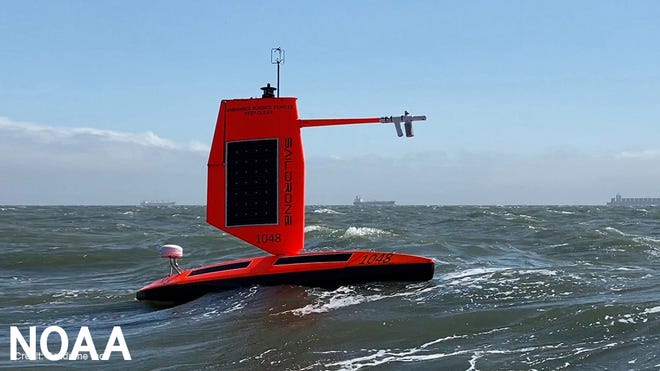- In 2021, a saildrone collected critical data and the first-ever video from inside Category-4 Hurricane Sam.
- This year, for the first time, two of the saildrones will also prowl the Gulf of Mexico.
- The drones are equipped with a specially designed hurricane wing.
Saildrones, so-called “robot surfboards,” will be guided into hurricanes in the Atlantic for the second straight year, with the goal of improving storm forecasts.
The seafaring drones are equipped with a specially designed hurricane wing, which allows them to operate in the extreme wind conditions encountered in hurricanes.
Greg Foltz, an oceanographer at NOAA’s Atlantic Oceanographic and Meteorological Laboratory in Miami told USA TODAY that the saildrones are not moored. “They are deployed near land during June and July and then directed to predefined regions where hurricanes have historically tracked. The saildrones then operate and send back data during the peak of the hurricane season (August to October).
“They are directed remotely by saildrone pilots working with NOAA scientists, and their routes are adjusted based on whether there is a tropical cyclone developing that we can send the drones into.”
WATCH:Uncrewed robotic vehicles deployed in Gulf of Mexico to gather hurricane data
PLANNING A VACATION?:How to steer clear of hurricanes, wildfires and other disasters.
This year, three of the saildrones will also work together with underwater gliders to obtain measurements of the upper ocean and air-sea interface.
One specific aspect of forecasts studied will be the rapid intensification of hurricanes.
By bringing the saildrones and underwater gliders close to each other, NOAA can then capture measurements at the same place and time, painting a fuller picture of the dynamics that are known to influence hurricane strength, said Jennie Lyons, director of public affairs at NOAA’s National Ocean Service.
“Storms that intensify rapidly can cause extensive damage and loss of life,” said John Cortinas, the director of NOAA’s Atlantic Oceanographic and Meteorological Laboratory, in a statement. “Real-time observing systems are crucial to better understand the atmospheric and oceanic processes that lead to the formation and intensification of these hurricanes,” he added.
During the 2021 hurricane season, a saildrone collected critical data and the first-ever video from inside Category-4 Hurricane Sam as it churned out in the Atlantic.
A recent study using that data found that the saildrone’s wind measurements taken from Hurricane Sam matched measurements from satellites and a buoy, providing confidence in the saildrone’s ability to collect accurate data in the harsh conditions of a major hurricane, NOAA said.
This year, for the first time, two of the saildrones will also prowl the Gulf of Mexico, and will be used to gather information if hurricanes approach the Gulf Coast.
NOAA predicts an above-average 2022 hurricane season, with up to 21 named storms and three to six major hurricanes. According to NOAA, hurricanes don’t only present a persistent threat to human safety in coastal cities, they also present a significant economic impact – hurricane damage in the U.S. is estimated at around $54 billion annually.
The saildrones will transmit meteorological and oceanographic data, including air temperature and relative humidity, barometric pressure, wind speed and direction, water temperature and salinity, sea surface temperature, and wave height and duration.
“The data obtained by the saildrones will be made available to NOAA researchers as well as NOAA forecasters in near real-time,”Foltz said. “It will also be transmitted in near real-time to the World Meteorological Organization’s global telecommunications center, where it is also available to forecast centers around the world.”
HURRICANE SEASON:Top forecasters still expect above-normal activity
CHECK THE WINDOWS:How to stay safe from hurricane dangers and damages
However, at least for now, the data “will not be ingested in into NOAA’s operational hurricane forecast models. At this stage, the data is for general awareness of forecasters at NOAA’s National Hurricane Center,” Foltz said.
NOAA is working to develop a way for operational forecast models to use the saildrone data in the future, he added. That work involves testing how the data would affect current forecasts and how it might improve accuracy.
There are a total of seven saildrones in use this year, which are a part of a larger NOAA endeavor to understand hurricane intensification. They will join the array of underwater gliders, surface drifters, profiling floats and aerial assets to gain deeper insight than ever before into the development of these killer storms.
Contributing: Dinah Voyles Pulver, USA TODAY



